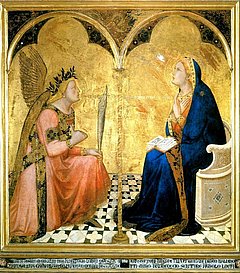Catherine de Sienne (1347-1380), mystique et docteur de l'Eglise nous fait contempler l'Incarnation : le désir de Dieu, son amour qui vient épouser notre humanité, et la force avec laquelle Marie donne volontairement son adhésion.
La grandeur du dessein de Dieu, créateur et rédempteur
« Si je considère ton grand conseil, O Trinité éternelle, je vois que dans ta lumière tu as vu la dignité et la noblesse de la génération humaine de sorte que, comme l'amour te contraignit à tirer de toi l'homme [dans la création], l'amour te contraignit aussi à le racheter [rédemption] lorsqu'il s'est perdu. »[1]
« Dieu voyant que sa volonté [de nous donner vie éternelle] ne pouvait pas se réaliser à cause du péché, contraint par l'amour fou qu'il avait envers nous, il nous envoya son fils unique et bien-aimé [...] afin que, dans le sein de Marie, son Verbe fut greffé dans notre humanité. »[2]
L'Incarnation, les noces de l'Alliance entre Dieu et l'humanité
« Quand vint la plénitude du temps sacré, le grand médecin du monde est venu, ton fils unique bien-aimé ; l'époux s'unit à l'épouse : la divinité [présente] dans le Verbe [s'unit] à notre humanité ; et cette union est advenue par Marie qui revêtit l'époux éternel de son humanité. »[3]
Marie est le champ où fleurit la semence de la Parole incarnée,
... le livre où nous apprenons la doctrine : le Verbe
« La glorieuse Vierge Marie fut ce doux champ, où la semence de la Parole incarnée du Fils de Dieu fut semée... Ce Verbe, greffé dans son chair, fit comme la graine jetée dans la terre qui germe grâce à la chaleur du soleil et produit la fleur et le fruit... O bienheureuse et douce Marie, tu nous as donné la fleur du doux Jésus. »[4]
« Le Fils a [de Marie] la forme de la chair [la nature humaine], et elle, comme la cire chaude, elle a reçu [de Lui] l'empreinte du désir et de l'amour de notre salut, par le sceau, le Sceau de l'Esprit Saint par lequel s'est incarné ce Verbe éternel divin. »[5]
« [O Marie, mon doux amour] en toi le Verbe est écrit, lui par qui nous avons la doctrine de la vie : tu es la Table qui nous donnes cette doctrine »[6]
« Marie, tu t'es faite Livre sur lequel aujourd'hui est écrite notre règle. En toi aujourd'hui la Sagesse du Père éternel est écrite, en toi aujourd'hui se révèle la force et la liberté de l'homme, car si je regarde en toi, Marie, je vois la main de l'Esprit Saint qui a écrit en toi la Trinité, en formant en toi le Verbe incarné, Fils unique et bien-aimé de Dieu. »[7]
« Autrement nous ne pourrons pas voir notre dignité, si nous n'allons pas nous regarder dans le miroir de la mer paisible de l'essence divine [par la voie de la connaissance]. Parce que de là nous sommes sortis, la Sagesse de Dieu nous ayant créés à son image et ressemblance ; là nous trouvons l'union du Verbe greffé dans notre humanité ; nous trouvons, nous voyons et nous goûtons la fournaise de sa charité. »[8]
Catherine souligne avec force la valeur du libre Fiat de Marie
« Il attendait [le Fils de Dieu] à la porte de ta volonté que tu lui ouvres, car il voulait venir en toi, et il ne serait jamais entré si tu ne lui avait pas ouvert en disant: "Voici la servante du Seigneur, qu'il me soit fait selon ta parole." »[9]
« La déité [la Trinité] éternelle frappait à ta porte, o Marie : mais si tu n'avais pas ouvert la porte de ta volonté, Dieu ne se serait pas incarné en toi. »[10]
« En toi, o Marie, aujourd'hui (fête de l'Annonciation) se montre la force et la liberté de l'homme parce qu'après la délibération d'un si grand conseil, l'ange est envoyé vers toi pour t'annoncer le mystère du conseil divin et demander ton consentement ; et le Fils bien-aimé de Dieu ne descend pas dans ton sein avant que toi-même ne le lui ait permis par ta volonté. »[11]
Catherine murmure à Dieu : O feu, abîme de charité...
« O feu, abîme de charité : pour que nous ne soyons pas séparés de toi, tu as voulu faire une greffe de toi en moi. Il en fut ainsi quand tu semas ton Verbe dans le champ de Marie. »[12]
Notes :
[1] Oraison O XI, [56-60], G. CAVALLINI (ed), S. CATERINA DA SIENA, Le Orazioni, Ed. Cateriniane - Roma 1978., p.122
[2] Lettre 97 [à Monna...] dans U.MEATTINI (ed), S. CATERINA DA SIENA, Epistolario, Ediz. Paoline, Torino 1993. (non è ancora un edizione critica), p. 1121
[3] Oraison O XII [28.30-34] G. CAVALLINI, op. cit., p.138-140, traduction F.Breynaert
[4] Lettre 342 [à Don Roberto de Naples], dans U. MEATTINI, op. cit., p. 1700-1701
[5] Epistolario, L. 30, à l'Abbesse de Marthe de Sienne, op. cit. p.1199
[6] Oraison O XI, [126- 128], G. CAVALLINI (ed), S. CATERINA DA SIENA, Le Orazioni, Ed. Cateriniane - Roma 1978, p. 128.
[7] Oraisons O XI, [44-50], G. CAVALLINI (ed), op. cit., p. 122.
[8] Lettre 226, Epistolario, U. MEATTINI [ed], op. cit. p. 1288.
[9] Oraisons O XI, [106-111], G. CAVALLINI, op. cit., p.126
[10] Ibid. [118-121], p.128
[11] Ibid. [101-106], p. 126
[12] Lettre L 77 [au Frère Guillaume d'Angleterre...] U. MEATTINI, p.1431
Bibliographie :
V. ROMANO, OP, Dimensione trinitaria della dottrina mariologica in santa Caterina da Siena In "Marianum 1-2, (2003), 131-206
Synthèse F. Breynaert
Lire plus sur Catherine de Sienne, docteur de l'
arget="_blank" href="/index.php?id=138954&tx_ifglossaire_list%5Bglossaire%5D=179&tx_ifglossaire_list%5Baction%5D=details&tx_ifglossaire_list%5Bcontroller%5D=Glossaire" title="- L’Eglise-Sacrement du Christ : « "Le saint Concile souh..." class="definition_texte">Eglise (1347-1380)

